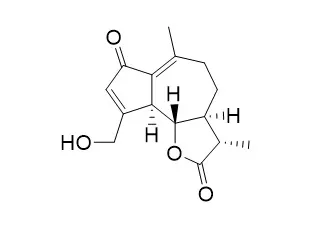| Cichorium intybus L. or chicory plants are a natural source of health-promoting compounds in the form of supplements such as inulin, as well as other bioactive compounds such as sesquiterpene lactones (SLs). After inulin extraction, chicory roots are considered waste, with most SLs not being harnessed. We developed and optimized a new strategy for SL extraction that can contribute to the conversion of chicory root waste into valuable products to be used in human health-promoting applications. In our work, rich fractions of SLs were recovered from chicory roots using supercritical CO2. A response surface methodology was used to optimize the process parameters (pressure, temperature, flow rate, and co-solvent percentage) for the extraction performance. The best operating conditions were achieved at 350 bar, 40 °C, and 10% EtOH as a co-solvent in a 15 g/min flow rate for 120 min. The extraction with supercritical CO2 revealed to be more selective for the SLs than the conventional solid-liquid extraction with ethyl acetate. In our work, 1.68% mass and a 0.09% sesquiterpenes yield extraction were obtained, including the recovery of two sesquiterpene lactones (8-deoxylactucin and 11β,13-dihydro-8-deoxylactucin), which, to the best of our knowledge, are not commercially available. A mixture of the abovementioned compounds were tested at different concentrations for their toxic profile and anti-inflammatory potential towards a human calcineurin/NFAT orthologue pathway in a yeast model, the calcineurin/Crz1 pathway. The SFE extract obtained, rich in SLs, yielded results of inhibition of 61.74 ± 6.87% with 50 μg/mL, and the purified fraction containing 8-deoxylactucin and 11β,13-dihydro-8-deoxylactucin inhibited the activation of the reporter gene up to 53.38 ± 3.9% at 10 μg/mL. The potential activity of the purified fraction was also validated by the ability to inhibit Crz1 nuclear translocation and accumulation. These results reveal a possible exploitable green technology to recover potential anti-inflammatory compounds from chicory roots waste after inulin extraction. |






 Cell. 2018 Jan 11;172(1-2):249-261.e12. doi: 10.1016/j.cell.2017.12.019.IF=36.216(2019)
Cell. 2018 Jan 11;172(1-2):249-261.e12. doi: 10.1016/j.cell.2017.12.019.IF=36.216(2019) Cell Metab. 2020 Mar 3;31(3):534-548.e5. doi: 10.1016/j.cmet.2020.01.002.IF=22.415(2019)
Cell Metab. 2020 Mar 3;31(3):534-548.e5. doi: 10.1016/j.cmet.2020.01.002.IF=22.415(2019) Mol Cell. 2017 Nov 16;68(4):673-685.e6. doi: 10.1016/j.molcel.2017.10.022.IF=14.548(2019)
Mol Cell. 2017 Nov 16;68(4):673-685.e6. doi: 10.1016/j.molcel.2017.10.022.IF=14.548(2019)